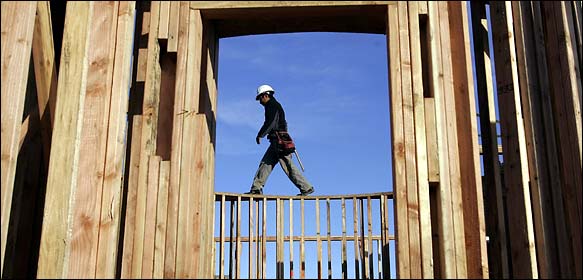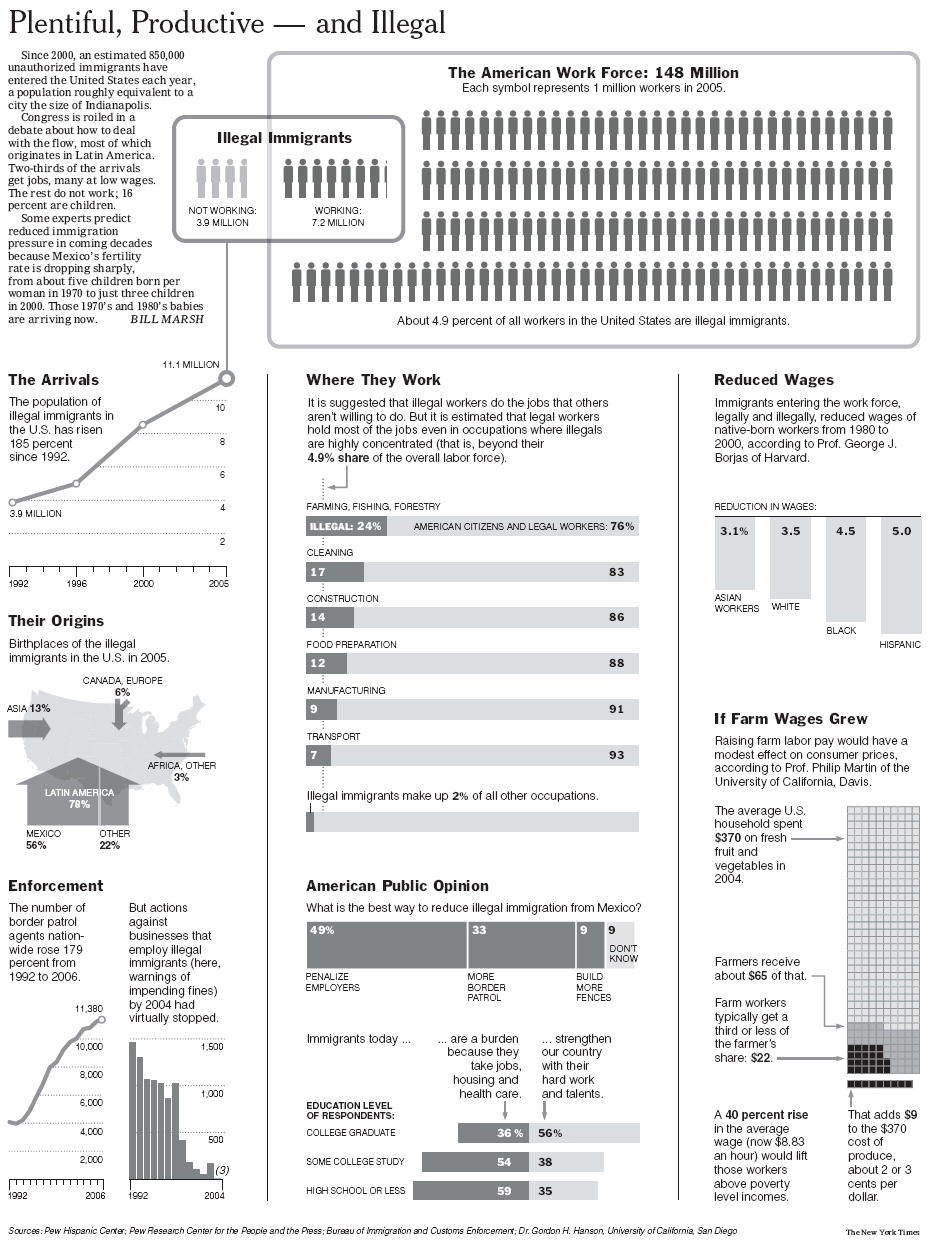| Want to send this page or a link to a friend? Click on mail at the top of this window. |
| Posted April 2, 2006 |
 |
Justin Sullivan/Getty Images |
| JOBS LOST AND FOUND At California construcrtion sites like this ones, well-paid work that used to go to native-americans is going to lower-paid immigrants. |
| Immigrants and the Economics of Hard Work |
By JOHN M. BRODER |
IT is asserted both as fact and as argument: the United States needs a constant flow of immigrants to perform jobs Americans will not stoop to do.
But what if those jobs paid $50 an hour, with benefits, instead of $7 or $10 or $15?
"Of course there are jobs that few Americans will take because the wages and working conditions have been so degraded by employers," said Jared Bernstein, of the liberal Economic Policy Institute. "But there is nothing about landscaping, food processing, meat cutting or construction that would preclude someone from doing these jobs on the basis of their nativity. Nothing would keep anyone, immigrant or native born, from doing them if they paid better, if they had health care."
 |
The most comprehensive recent study of immigrant workers comes from the Center for Immigration Studies, a group that, unlike Mr. Bernstein's, advocates stricter controls on immigration. The study, by the center's research director, Steven A. Camarota, found that immigrants are a majority of workers in only 4 of 473 job classifications — stucco masons, tailors, produce sorters and beauty salon workers. But even in those four job categories, native-born workers account for more than 40 percent of the work force.
While it might be a challenge to find an American-born cab driver in New York or parking lot attendant in Phoenix or grape cutter in the San Joaquin Valley of California, according to Mr. Camarota's study of census data from 2000-2005, 59 percent of cab drivers in the United States are native born, as are 66 percent of all valet parkers. Half of all workers in agriculture were born in this country.
| Is it significant that most low-level jobs are still held by native-born Americans |
"The idea that there are jobs that Americans won't do is economic gibberish," Mr. Camarota said. "All the big occupations that immigrants are in — construction, janitorial, even agriculture — are overwhelmingly done by native Americans."
But where they compete for jobs, he said, the immigrants have driven up the jobless rate for some Americans. According to his study, published in March, unemployment among the native born with less than a high school education was 14.3 percent in 2005; the figure for the immigrant population was 7.4 percent.
While Mr. Bernstein would agree that the least-educated American workers are at a disadvantage, he does not favor curbs on immigration. Even the least-skilled Americans benefit from the presence of a large pool of immigrant workers, Mr. Bernstein said. He said that the 11 million illegal immigrants are consumers, too, creating demand for goods and services and the jobs they produce. He also said their willingness to work at low wages helps keep inflation in check, benefiting the nation as a whole.
"It's quite clear that immigrants lead to lower prices of goods and services, and the lower inflation helps boost the economy, and that helps all Americans," Mr. Bernstein said. "You have a significant increase in the labor supply due to immigrant inflows, yet the wage effects seem isolated among the least educated, and they're not huge."
But George J. Borjas, a professor of economics and social policy at the Kennedy School of Government at Harvard University, said he believed that the flow of migrants had significantly depressed wages for Americans in virtually all job categories and income levels. His study found that the average annual wage loss for all American male workers from 1980 to 2000 was $1,200, or 4 percent, and nearly twice that, in percentage terms, for those without a high school diploma. The impact was also disproportionately high on African-Americans and Hispanic-Americans, Professor Borjas found.
"What this is, is a huge redistribution of wealth away from workers who compete with immigrants to those who employ them," he said.
There is one place and one category of work in which the "jobs Americans will not do" mantra appears to be close to true —the salad bowl of California. Tim Chelling, the communications director for the Western Growers Association, a cooperative of big farm operators, said that last winter growers in California's Imperial Valley needed 300 workers to harvest lettuce and broccoli.
They went to the local unemployment office, he said, and posted a notice seeking workers, who would be paid about $9 an hour and receive bare-bones health insurance. "Apparently one guy showed up, and he didn't last through the first morning," Mr. Chelling said. All the jobs went to Mexican laborers, most of them probably illegal, he said.
Mr. Chelling, whose group supports liberalized immigration laws and guest worker programs, argued that the use of immigrant labor was not a question of money, though growers certainly prefer to pay low wages to keep costs down. Farm labor is back-breaking, he said, requiring endurance, dexterity and patience that few Americans possess.
Last weekend, some 500,000 people took to the streets of Los Angeles to protest a tough immigration bill passed by the House in December and to put pressure on the Senate, which is debating the issue now. In the crowd were very few African-American faces, noted Ronald W. Walters, a professor of government and politics at the University of Maryland. Their economic prospects are directly threatened by the huge influx of illegal immigrants, he said. African-Americans are competing for jobs in construction, hotels and restaurants, meat packing and textiles, he said, and they lose out to immigrants willing to accept lower pay and fewer benefits.
"The African-American leadership has a lot of angst about this," he said, adding: "It's not just a black problem, but we are the most acutely affected. The fact is, it's hurting us."
Joel Kotkin, a fellow at the New America Foundation, a public policy institute, said that the American economy is large enough to absorb most of the new immigrants without pushing too many native-born Americans to the margins.
But he said the situation could change dramatically if the economy were to enter a downturn, particularly in the housing sector where thousands of immigrants are laborers. If the housing bubble popped, Mr. Kotkin said, competition for the remaining jobs would be fierce and could stoke anti-immigrant sentiments. He recalled the anti-immigrant proposition approved by Californians in 1994, when the state was mired in recession. "The important factor is the state of the economy," he said. "An economy that is growing rapidly can absorb these people more easily than one that isn't."
Copyright 2006 The New York Times Company. Reprinted from The New York Times, Week in Review, of Sunday, April 2, 2006.
| Wehaitians.com, the scholarly journal of democracy and human rights |
| More from wehaitians.com |